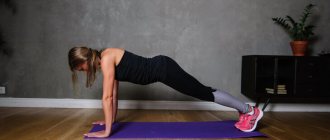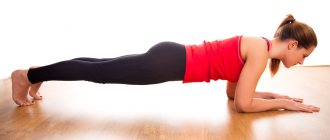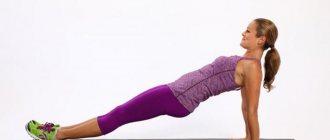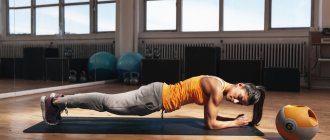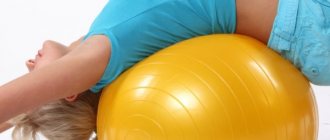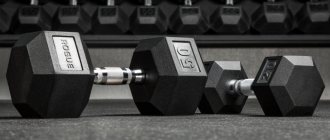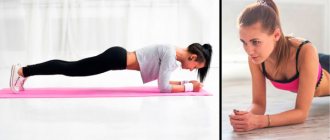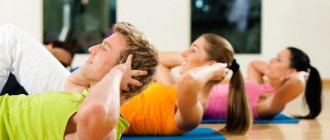The plank is a very popular fitness exercise that is used by both amateurs and professional athletes. Despite the fact that there is nothing complicated in doing it, it gives a high-quality load on the muscles and helps you lose weight. Let's try to answer the basic questions about the bar.
What is a plank
The plank is a universal isometric exercise that allows you to strengthen several muscle groups at once. It is performed statically, that is, during execution we do not move. The classic plank involves focusing on straight arms and toes. The body should be in a straight line, with the gaze directed forward. You need to stay in this position for a certain time.
There are different variations of the plank: on straight arms, on the elbows, reverse, with raising the legs and arms, side and so on. Combining them with dynamic exercises, you can achieve remarkable fat burning
Popular planking options: technique, nuances and differences
Classical
You should rest on your toes and forearms. The arms are bent at the elbows at an angle of 90 degrees, the forearms are parallel to each other. Your body is a straight line from head to toe. Tighten your buttocks and leg muscles. Do not lower your pelvis, do not raise or lower your head. Breathing is even.
Full or straight arms
Straighten your arms and lift your hips, keeping your hands on the floor. This plank may even seem easier for some people who have a more developed upper body. This variation will make your shoulders more stable than the classic one. The fingers should be spread wide and the middle finger should point straight ahead. Rotate the inside of your elbow forward to engage your biceps.
Lateral
Lie on your right side with your feet on top of each other. Place your lower right elbow directly under your right shoulder and lift your hip off the floor to create a straight line. You should feel tension in your waist area. Extend your left arm toward the ceiling or place it on your left thigh. Hold this pose for a few seconds, then repeat the same on the other, left side of the body. If you feel like one side of your body is stronger than the other, continue doing the same number of reps on each side to make them equally strong.
Lateral with leg lift
Once you have been able to hold a side plank for one minute, you can try this variation. Get into the side plank position and, holding the position, lift your upper leg a few centimeters from the floor, then, tensing your muscles and controlling the movement of your leg, lower it back. Perform 10 repetitions, then repeat on the other side.
Lateral with hips lowered
Standing in a side plank, lower your pelvis down without touching the floor, then return to the starting position. What gives? Increased load on obliques.
Full with leg lifts
Start in a full plank position, pressing your hands into the floor and keeping your hips and abdominal muscles tight. Lift one leg up, squeezing your buttocks. Keep your leg in the air for a few seconds, then move to the other leg and do the same. It is not necessary to raise your legs very high, it is important to stretch them away from you. Do 10 repetitions with each leg.
Reverse
Sit on the floor. Place your hands on the floor, moving them slightly back. Lift your pelvis up. The palms should be strictly under the shoulders. Dough on the palms and heels. Tighten your body, it should form a straight line.
On fitball
We perform the classic plank, but we raise our legs with the help of a fitball. The ball is under the feet.
Military or dynamic
Start in a basic plank position with your forearms on the floor. Now, pushing first with your right hand, then with your left, move into a full plank position. After this, lower yourself back to the base position, again starting from the right side. Do 10 reps on each side—10 reps on the right, then 10 reps on the left.
Climber or knee puller
Start in a full plank position, then tighten your abdominal muscles and pull your right knee toward your chest using your lower abdominal muscles. Return your right leg to the starting position and repeat the exercise for your left leg. Continue repeating the exercise with both knees 20-30 times. You can do it quickly or slowly, the main thing is the correct technique, because it is more important than speed.
With alternating shoulder touches
Start in a full plank position, keeping your hips as stable as possible. Reach your left shoulder with your right hand. Return your right hand to its original position, then touch your right shoulder with your left hand. Keep repeating this exercise 20-30 times.
What muscles work when doing a plank?
The exercise helps to work several muscle groups at once:
- The buttocks will become elastic and strong. This is achieved due to muscle tension during sagging.
- The muscles of the back and shoulders will be strengthened.
- All muscle groups of the legs are worked out.
- Abdominal muscles are strengthened.
- Arms are strengthened without developing large biceps, which is especially important for women.
To effectively work your abs, it is recommended to pull your stomach in and fix it until the end of the approach.
What are the benefits of the plank exercise?
Now let’s look at what the plank exercise gives:
- Helps increase elasticity and muscle tone throughout almost the entire body, including problem areas.
- For women, exercise is useful because it helps get rid of cellulite by improving blood supply to the thighs and buttocks.
- Strengthens the back and eliminates lower back pain, as the exercise helps to form a strong muscle corset.
- Also, the plank is a wonderful prevention of osteochondrosis.
- Improving the relief of the back and legs.
- The plank helps you lose weight due to the increased work of muscles that burn fat under static tension.
- Helps to achieve a beautiful flat stomach and firm breasts, as it strengthens the pectoral muscles.
- Helps you gain power over your body, learn to control yourself, and develop coordination.
Types of planks
The exercise can be diversified by removing the support points (arm or leg) and adding dynamic elements.
Types of planks:
- elbow bar (classic);
- on straight arms;
- with raised hand;
- with a raised leg;
- two points are involved, with the arm and leg of opposite sides raised;
- plank with push-ups;
- with steps;
- with twisting;
- with knee tightening;
- lateral;
- reverse plank.
An exercise that takes less than five minutes to complete can transform your body.
What happens if you do planks every day?
Of course, to achieve results you need to practice regularly, and not occasionally. If you do planks every day, the following things will happen to you:
- You will strengthen the muscles of the abdomen, back, shoulders, buttocks, legs. Although the exercise is performed for a short time, the load on the muscles is quite strong.
- Blood circulation and metabolic processes will improve. Due to the active work of muscles, blood circulates faster, as a result, the quality and speed of metabolism increases significantly.
- Increased flexibility. When regularly performing the plank, muscles and ligaments stretch and gain better elasticity.
- You can get rid of lower back pain that many suffer from. The exercise is especially useful for the prevention of scoliosis and osteochondrosis.
- The plank effectively works out the stomach, so it is useful for everyone who dreams of getting six-packs. During the exercise, all abdominal muscles are involved, including the deep and oblique muscles.
- This exercise will help you get slender and toned legs without making them too inflated.
- You will get beautiful and firm buttocks.
- Regular planking improves endurance. In the future, you will be able to hold it longer and longer and perform complex variations.
- Exercise helps maintain balance and teaches you to maintain balance.
- By doing the plank every day, you will improve your emotional state. The muscles first tense and then relax, and when they relax, emotional tension also disappears.
- You can lose weight and also prepare your muscles for other exercises.
How long should you hold the bar?
Now the most interesting thing - how long should you stand in the plank? Beginners are unlikely to be able to do this for more than 15-20 seconds, so this will be enough for a start. The optimal time for doing the plank will be different for everyone. Over time you can build it up to a few minutes, but at first keep it as long as you can. Trembling of tense muscles is normal for beginners.
How many times a day should you do the plank? The optimal scheme is 3-4 repetitions of 20-120 seconds, depending on your fitness level. Once you can hold a standard plank for two minutes without problems, you can make it more difficult and add other variations to the exercise.
It is recommended to devote at least 3-4 days a week to isometric exercises and combine them with others.
Tips for Beginners
Perform the exercise on a yoga mat or towel so that the hard floor does not cause additional discomfort to your elbows. Before exercise, warm up by stretching or doing some simple exercises for three minutes. The first days, stand in the plank for only 20 seconds. This is quite enough for a beginner. To make the exercise easier, place your feet hip-width apart.
If you don’t feel entirely confident in this position, then do it from your knees.
After a few days, when the muscles are stronger, make the knee plank more difficult by straightening one leg and holding it suspended. Stand like this for 30 seconds, then change legs. After finishing the exercise, we recommend taking balasana - child's pose. This will relieve tension and relax your core muscles.
How to do a plank correctly
The classic version of the exercise is as follows: lie on the floor on your stomach, bend your arms at the elbows to form a right angle. Now gather your strength and lift your body on your toes and forearms so that it forms a straight line. At the same time, it should be taut like a string.
In the correct position, your elbows should be under your shoulders. We linger in this position as long as we can.
Having mastered the basic plank, you can begin to perform the side plank, which is done as follows: lie on your side, leaning on your bent elbow, place your other hand on your thigh and lift your torso off the plane with emphasis on the elbow and the side of the foot. The legs must be kept together. Lift your torso from the plane and hang in this position for a specific time. It is important to perform the exercise on both sides in order to work the muscles evenly and harmoniously.
When the classic and side planks are easy for you, you can add new elements that will make the exercise more complex and effective.
- In the basic plank, lift your leg or arm up and hold it in this position. Particularly experienced athletes lift their arms and legs simultaneously from opposite sides, holding on to just two points.
- When performing a side plank, you can lift your top leg.
- You can use a sports ball and lean on it while exercising with your arms or legs.
Reaching plank
Starting position: plank, place your palms directly under your shoulders, keep your lower back in a neutral position. As you exhale, pull the knee of one leg towards your chest, transferring your body weight to your palms. As you exhale, pushing your palms off the floor, stretch your toes back and up. Do not place your working leg on the floor, but immediately from the top point take it to your chest as you exhale. Perform the exercise smoothly, without jerking.
How many times to perform: 3-5 sets of 12 repetitions on each leg.
Walking on your buttocks and other fun exercises that are most effective Read
Features of the correct technique
To get maximum results from the exercise, it must be performed correctly from a technical point of view. To achieve this, consider the following points:
- You need to keep your back straight, maintain the absolute plane of the lumbar region. When bending or rounding, the effectiveness of the exercise decreases and the risk of injury increases.
- The buttocks need to be tensed - this will ensure the highest quality development of them, the core muscles.
- The legs should be straight along the entire length; even slight bending of the knees is not allowed, since due to the incorrect position of the legs, the lumbar area is overloaded, and the exercise becomes more difficult.
- Correct body position is very important. As with many other isometric exercises, the placement of the joints under the joints is important, that is, the wrists or elbows, depending on the plank variation, should be located strictly under the shoulders.
- The pelvic area should be aligned clearly parallel to the floor line. Correctly twisting it helps reduce the load on the lower back.
- The head, neck and shoulders should be in one line and relaxed. It is recommended to look straight ahead.
- You definitely need to tense your abdominal muscles, pull your stomach in as much as possible, but so that this does not interfere with your breathing calmly and measuredly while doing the exercise.
Execution technique
If you decide to seriously master this exercise for losing weight in the abdomen and other parts of the body, you need to become familiar with the technique. If there are violations, you can not only fail to achieve results, but also ruin your health. How to perform the “plank” correctly:
- We lie down on our stomachs.
- We straighten our arms and at the same time raise our upper torso. As a result, your hands should be positioned under your shoulders.
- We rest our toes on the floor.
- We squeeze the pelvis.
- In this pose, the body should form a straight line.
- We fixate and hold for the required time.
- Then we relax and repeat the exercise again.
Plank exercise: contraindications
Despite all the benefits and simplicity of the exercise, you need to take into account the presence of contraindications , which include the following:
- Pregnancy and the postpartum period, especially if a caesarean section was performed. In the latter case, it is recommended to refrain from performing the exercise for six months, but this period can be increased depending on the individual characteristics of the body.
- Problems with the joints of the hands, shoulders, elbows, feet. Contraindications also include high blood pressure.
- It is prohibited to perform the plank if you have a herniated spine or other injuries of the musculoskeletal system.
- Exacerbation of chronic diseases.
If an exercise causes discomfort, stop doing it and consult a specialist. Also, unpleasant sensations can be a consequence of incorrect exercise technique.
Tips for performing the classic plank ↑
The technique for performing the classic version of this exercise is extremely simple, which is why many people make a number of mistakes. To protect you from them, we have selected a number of tips. Following them will allow you to get truly impressive results after just a month of stable training.
Hands ↑
The classic execution involves standing on your elbows. Make sure that your shoulder is perpendicular to the floor line and your forearms are flat on the floor and parallel to each other. Whether your palms are clenched or remain relaxed does not matter, do what is most convenient for you.
The deltoid muscles located on the shoulder joint should not be strained too much. Position your arms so that all your weight rests on your elbows, not on them. By the way, if it’s hard for you to do the plank in this position, then clasp your hands together. In this position they should form a triangle, this will somewhat reduce the load on this part of the body.
Back and abs ↑
This area plays the most important role in the entire exercise. It is on how your spine is positioned that all implementation and results will depend. The back must be straight, there is no need to bend down or round it. Feel your spine, it should be as straight as possible.
It is advisable to pull the tailbone down a little; in this position, deflection of the lower part of the spine is almost impossible. To make sure the execution is correct, perform the first approaches in front of a mirror, or ask your loved ones to watch you from the side.
The abs must be kept in constant tension; of course, this usually happens physiologically, but towards the end of the exercise, relaxation of the abdominal muscles is quite often observed. If you encounter this, then try to consciously tense this muscle group again, but if this is not possible, then reduce the execution time a little until your core is sufficiently strong.
Buttocks and thighs ↑
The hips are precisely the instrument that allows you to regulate the evenness of the spine and the lowering of the pelvis. If you do everything right, you will feel tension, especially in the front.
The buttocks must be kept tense all the time, or done at some intervals. In any case, even if you do not place special emphasis on the development of these muscles, following this recommendation will have a positive effect on strengthening the entire core as a whole.
Useful article on the blog: “Which muscles need to be pumped for the abdominal press: strength training” By normalizing proper nutrition and adding dynamic movements to your workouts, you will be able to see the fruits of your labors.
Legs ↑
Depending on how wide you place your legs, the workload of the lumbar region and back extensors will depend. When your toes are too close to each other, it distributes your weight into 3 points - two elbows and feet. If you place your socks shoulder-width apart, there will be 4 support points, and therefore the load will be distributed evenly.
Breathing ↑
This is another very important component of this exercise. Breathing should be smooth and without delay. You should remember that no muscle can work properly unless it is saturated with oxygen.
You can link the cycle of muscle relaxation and tension to this very process. For example, as you inhale, relax the abdominal and gluteal muscles, and as you exhale, contract them. In any case, regular breathing is incredibly important; if you do not breathe correctly, it will greatly affect the results.
How to increase the effectiveness of the exercise
The plank is great for helping you lose weight and work out your muscles, but it’s not enough to achieve clear progress. It is also recommended to perform other exercises. A particularly good effect is achieved when alternating the plank with a dynamic load. If you want to build muscle, focus on strength training, if you want to lose weight, focus on cardio training.
In addition, nutrition is very important. You need to eat often and in small portions, build your diet on protein foods, complex carbohydrates, fruits and vegetables. It is also necessary to drink plenty of fluids.
The plank is a simple and effective exercise that will help you lose weight and strengthen your muscles. Start doing it regularly, and soon you will notice clear changes for the better in many aspects.
